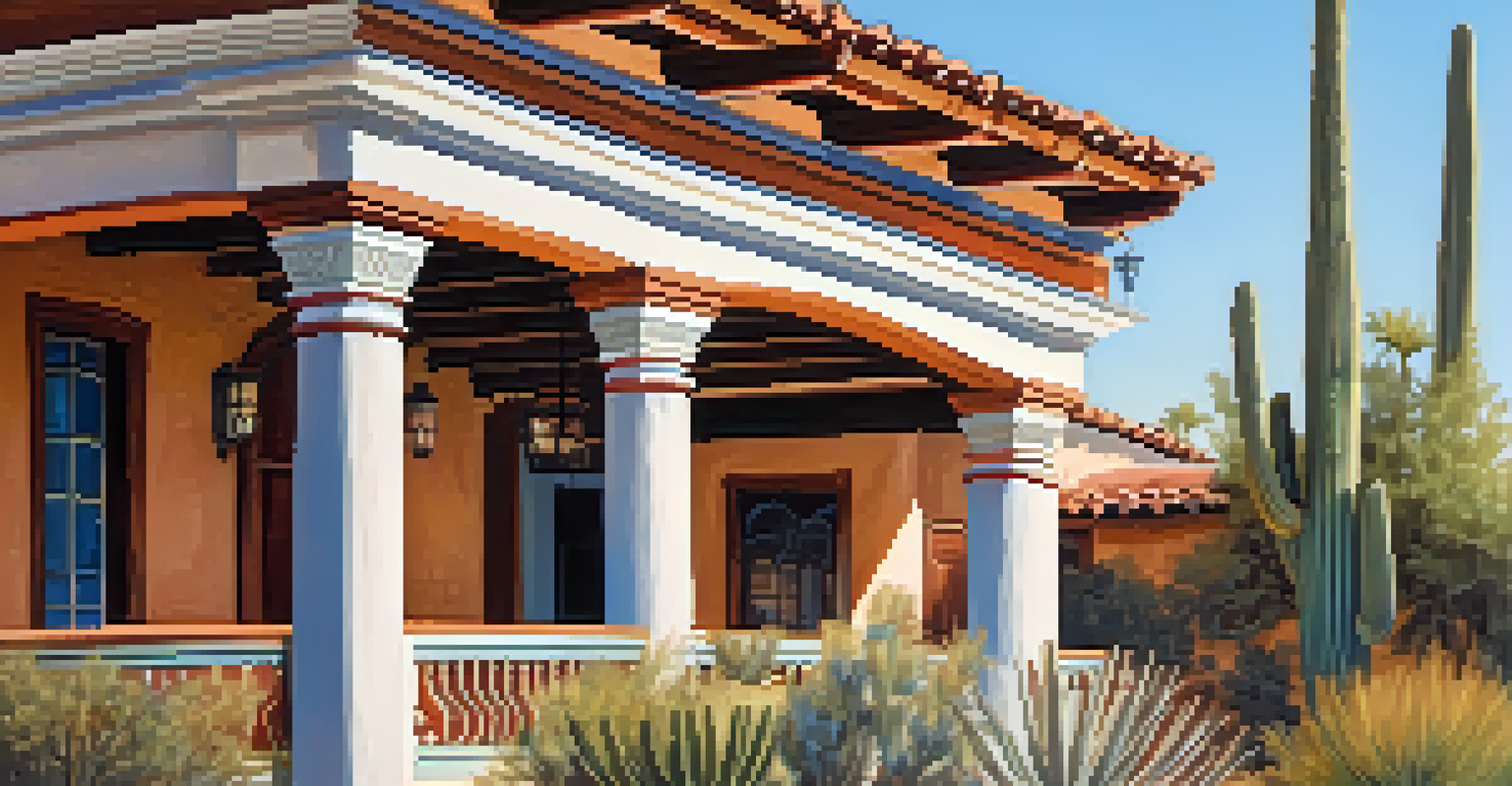The Historical Roots of Tucson's Preservation Policies Explained

Tucson's Unique Historical Context and Heritage
Tucson's history is a tapestry woven from diverse cultures, including Native American, Spanish, Mexican, and Anglo influences. This multicultural backdrop has shaped the city’s identity and contributed to its unique architectural styles. Understanding this context is crucial for appreciating the need for preservation policies that honor these varied heritages.
Preservation is the key to a community's identity.
As Tucson developed, it became a melting pot of traditions and architectural influences, from adobe structures to modern buildings. This rich legacy highlights the importance of preserving historical sites that tell the city's story. Each landmark serves as a reminder of Tucson's evolution and the people who have called it home.
The city’s historical context is not just about old buildings; it reflects the values and experiences of its inhabitants. Preservation policies in Tucson aim to protect these narratives, ensuring that future generations can connect with their history and culture.
The Role of Preservation in Urban Development
Urban development often comes with the threat of erasing historical landmarks. Tucson has faced this challenge head-on, balancing growth with preservation through thoughtful policies. By integrating preservation into urban planning, the city aims to maintain its character while accommodating modern needs.

For example, designated historic districts in Tucson ensure that new developments respect the architectural integrity of the area. These policies allow for a harmonious blend of old and new, fostering a vibrant community that honors its past. This balance is essential for creating spaces that are both functional and reflective of Tucson's heritage.
Tucson's Rich Cultural Heritage
Tucson's diverse history, shaped by various cultures, underscores the importance of preservation policies that honor its unique identity.
Moreover, preservation efforts can stimulate local economies by attracting tourism. Visitors drawn to Tucson's rich history often support local businesses, creating a win-win situation for both preservationists and the community.
Early Preservation Efforts in Tucson
Tucson's journey toward preservation began in the mid-20th century, as awareness grew about the importance of protecting historical sites. Early advocates recognized that many buildings were at risk of demolition due to urban sprawl and modernization trends. This sparked grassroots movements aimed at raising public awareness and rallying support for preservation initiatives.
History is not a burden on the memory but an illumination of the soul.
One significant milestone was the establishment of the Tucson Historic Preservation Commission in 1976, which formalized efforts to protect the city’s heritage. This commission played a key role in identifying historically significant structures and advocating for their preservation. It marked a turning point in the city’s approach to safeguarding its history.
These early efforts laid the groundwork for more comprehensive preservation policies that would come in the following decades. They demonstrated the community's commitment to maintaining Tucson's unique character and the desire to celebrate its diverse historical roots.
Legislation Influencing Tucson's Preservation Policies
Legislative measures have played a crucial role in shaping Tucson's preservation policies. The National Historic Preservation Act of 1966 was particularly influential, providing a framework for local governments to protect their historical sites. Tucson leveraged this act to develop its own preservation strategies, ensuring that local heritage was recognized and protected.
In addition to federal support, Arizona state laws have also contributed to Tucson's preservation efforts. State legislation encourages municipalities to create preservation plans and provides funding for restoration projects. This legal backing has empowered Tucson to take proactive steps in safeguarding its historical sites.
Balancing Growth and Preservation
Thoughtful urban planning in Tucson integrates preservation into development, ensuring that new projects respect the city's historical landmarks.
As a result of these legislative influences, Tucson has established a robust preservation framework that balances development with heritage conservation. This framework not only protects the past but also enriches the community, fostering a sense of pride among its residents.
Community Engagement in Preservation Efforts
Community engagement is a cornerstone of Tucson's preservation policies. Local residents, historians, and preservationists often come together to voice their opinions and participate in decision-making processes. This collaborative approach ensures that the preservation efforts reflect the values and aspirations of those who live in the community.
Public forums, workshops, and advocacy groups play vital roles in raising awareness about the importance of preserving Tucson’s heritage. These platforms provide opportunities for residents to learn about historical sites and their significance, fostering a deeper appreciation for local history. Engaged communities are more likely to support preservation initiatives and advocate for their continued relevance.
Furthermore, the involvement of community members in preservation efforts can lead to innovative solutions that address both historical integrity and contemporary needs. This synergy between residents and policymakers creates a dynamic environment where preservation thrives alongside urban development.
Impact of Preservation Policies on Tucson's Identity
Preservation policies in Tucson have a profound impact on the city’s identity, serving as a reflection of its values and aspirations. By protecting historical sites and landscapes, Tucson fosters a sense of belonging and pride among its residents. This connection to the past enriches the community’s narrative and informs its future direction.
Moreover, these policies contribute to a unique sense of place that distinguishes Tucson from other cities. The preservation of historical landmarks and neighborhoods creates a character that is both charming and authentic. Visitors often remark on the city’s distinct atmosphere, which is a direct result of these thoughtful preservation efforts.
Community Involvement in Preservation
Active engagement from local residents and organizations is essential for preserving Tucson's heritage and reflecting the community's values.
Ultimately, Tucson’s commitment to preserving its history enhances its cultural richness, making it a vibrant and attractive place to live. This identity not only supports local pride but also draws in tourists who are eager to explore its historical treasures.
Looking Ahead: Future of Preservation in Tucson
As Tucson continues to evolve, the future of preservation will depend on adapting to new challenges and opportunities. The city faces pressures from rapid development and changing demographics, necessitating a flexible approach to heritage conservation. Policymakers and community members will need to collaborate to ensure that preservation remains a priority amid these changes.
Innovative strategies, such as utilizing technology for documentation and engagement, may play a significant role in future preservation efforts. Digital tools can help raise awareness and create virtual tours of historic sites, making them accessible to a broader audience. This adaptability will be key to maintaining Tucson's rich heritage in a modern context.

Moreover, fostering intergenerational dialogue about preservation will ensure that diverse perspectives are considered. Engaging younger generations and newcomers to the city will help sustain the momentum of preservation efforts and inspire a collective commitment to safeguarding Tucson’s historical roots.